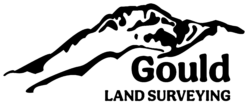Though a land surveyor is frequently associated with construction staking or engineering the main reason that land surveyors exist in the private sector is to find and identify boundary lines. The principle reason that a land surveyor is licensed in a given state is to serve and protect the public in regards to this fact. Boundary surveying is an evidence gathering process that starts in the office and then goes to the field to continue that gathering of evidence. In the end, the surveyor produces a document that shows the results of all this work.
A land surveyor’s role is quasi-judicial, this means that we should not be biased or take sides in a given boundary dispute like an attorney would. Nor does a surveyor represent you like a real estate agent would. In both Arizona and Colorado, the State Statutes declare that to land survey, one must be licensed by the state. Gould Land Surveying is license in both Colorado and Arizona!
Q: What is a boundary survey?
A: It is a type of land survey to locate boundary lines or one or more corners of a subject parcel. It is sometimes called a certified boundary survey. The document produced showing the results of this work is called a Record of Survey (ROS) in Arizona or a Land Survey Plat (LSP) in Colorado. This type of survey includes looking for existing boundary monuments on the subject parcel as well as looking for boundary monuments on adjacent parcels. At the end of the survey, we set any boundary monuments that are missing on the subject parcel. We have to do this level of work because no parcel sits independently – it has to be in harmony with the other parcels that surround it. We need to locate the boundary monuments on adjacent parcels in order to “prove” the boundary monuments on the subject parcel. The final drawing shows the results of this work and the boundary analysis. An ROS/LSP usually excludes showing physical features except along the boundary lines where fence/wall lines, tree lines, or hedge lines serve as boundary line evidence to consider during boundary analysis.
Q: Will you identify the boundary monuments on site so that I can see where my corners are?
A: Yes, For each boundary monument found or set on the subject parcel we also set a 4′ lath next to it and tie survey flagging on it so that it can be easily seen.
Q: Is there a chance the boundary monuments are already there?
A: Yes, most likely all or some of the boundary monuments marking the corners are there, possibly below grade where you can’t see them. This is part of what we look for when we do the field for a boundary survey and we set the boundary monuments that might be missing.
Q: Would the final price of the survey vary depending on how many boundary monuments are already there?
A: No, pricing is not on a per boundary monument basis. For surveying, costs are driven by two factors – amount of work involved and professional liability. Even if the boundary monuments are there, we still have the time and work involved to find them (this includes office research and calculations time as well as labor time in the field). Furthermore, it’s not just the subject parcel’s boundary monuments we have to look for. Professional surveying requires us also look for the pins on adjacent parcels as well in order to prove the ones on the subject parcel. Drive time to the site is also a factor. If the subject parcel is “out in the middle of nowhere” or at least a long drive from the surveyor’s office, this has to be factored into the price.
Q: Is it possible to skip a full ROS/LSP and just have you come out and flag up my boundary monuments to save money?
A: No, if we just come out and flag the boundary monuments where they are, without doing the work of evidence finding/analysis and locating other boundary monuments to check against, we are doing a dis-service to the public. If one or more of those boundary monuments are off, then we have told you that this is where your corner is, when that’s really not where it is. In addition to this, a surveyor just doesn’t magically know where boundary monuments are, there is a lot of pre-field work research and calculations that have to be completed in the office prior to showing up on site of the subject parcel. This amount of work, combined with the reasons stated above, is why Gould Land Surveying does not engage in “find and flags.” In Colorado, the State Board that governs land surveyors actually frowns on this practice because of the reasons stated above. Also Colorado statutes clearly state that if we come out and participate in survey work, we have to deliver a document to you showing the results of that work.
Q: Does the survey have to be filed anywhere?
A: It depends.
In Arizona, if we have to set any missing boundary monuments on the subject parcel or upgrade a found boundary monument on the subject parcel, then yes, we have to record our survey per State Statutes. This recording is in the County Recorder’s Office so that it is in the public records database.
In Colorado, if the subdivision the subject parcel is located in is less than 20 years old, then the answer is no. But if it is more than 20 years old, or the subject parcel is not in a platted subdivision (e.g. metes & bounds or aliquot part type of legal description) then the answer is yes. The survey is deposited with the County Recorder so that it is in the public records database.
When do you need a land survey?
https://www.mesacounty.us/departments-and-services/surveyor/when-you-need-land-survey
